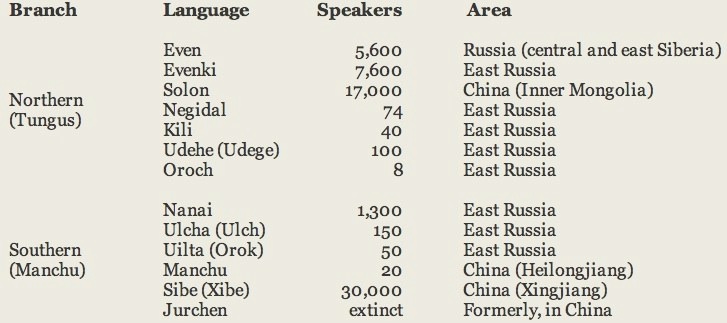An insatiable appetite for ancient and modern tongues


Alternative Names: Manchu-Tungusic, Manchu-Tungus.
Overview. Tungusic designates a group of agglutinative languages spoken in the extreme northeast of Asia by scattered communities that were originally nomadic hunters and herders or fishermen along the Pacific coast. Most of them are in the verge of extinction pressurized by Russian and Chinese languages and policies. Two Tungusic peoples, the Jurchen and Manchu, managed in different epochs to build great empires and to leave substantial written records.
Distribution. Tungusic languages are found in Central-East Siberia in Russia, and in Inner Mongolia, Manchuria and the region of Xinjiang in China.
External Classification. Tungusic is considered one of the three subfamilies of the Altaic family by many scholars (with Mongolic and Turkic). However, the parallelisms between Tungusic and Turkic languages are too few, according to others, to support this classification and, therefore, it may be and independent family.
Internal Classification and Speakers. Tungusic languages can be divided into Northern or Tungus, and Southern or Manchu branches:

Status. Tungusic languages are spoken by less than 70,000 people spread across a very vast territory. Most of them are endangered or in the verge of extinction. Their decline is due in great measure to the forced assimilation imposed by Russian and Chinese governments, particularly during the Stalin and Mao eras.
Oldest Documents. Jurchen is the oldest attested member of the Tungusic family. The Jurchen people, the founders of the Jin empire, left, in Manchuria and Korea, a number of stelae dating from the 12th century written in the Jurchen script. Manchu, the official language of the Qin dynasty of China, is abundantly preserved in official documents and translations dating from the 16th to the early 20th century.
Phonology of Evenki
It is shown here as an example of a Tungusic language. Other members of the family may have somewhat different systems.
Vowels (11). Evenki has short and long vowels and vowel length is phonemic in Evenki as in most Northern languages. In Manchu there is no vowel length contrast but there are vowel clusters, instead. Evenki exhibits vowel harmony like all Manchu-Tungusic languages.

Consonants (18). Stops (including affricates) are articulated at four points and each has contrasting voiceless and voiced varieties.

Scripts
-
•The Jurchen devised their own writing system which was based on the Khitan script with the addition of many Chinese characters. Many of its symbols were logographic but others represented sounds.
-
•Manchu uses a modified version of the Mongolian alphabet.
-
•Sibe is written with a modified form of the Manchu alphabet.
-
•A writing system based on the Latin alphabet was developed for Evenki in the 1920s but it was soon replaced by the Cyrillic alphabet.
-
•The other Tungusic languages are not normally written.
Morphology
Tungusic languages are agglutinative using suffixes as markers. They all have a complex nominal and verbal morphology, especially those in the Northern group. Derivational morphology is also rich, existing a great number of suffixes applied to nouns, verbs, and numerals to create new words.
Nominal
-
-Nouns are marked for case, number and, in some languages, possession (not in the Manchu subgroup). The number of cases is high varying from five in Manchu to thirteen in Evenki. In some languages, adjectives agree with the modified noun in number and case but in others are uninflected.
-
The cases in Evenki are: nominative (subject), accusative (definite direct object), indefinite accusative (indefinite direct object), dative (indirect object, purpose), allative (motion towards), locative, allative-locative, prolative (by way of, about), allative-prolative, elative (from the direction of), illative (into), ablative (source, comparison), instrumental (instrument). The nominative is unmarked serving as the base for the other cases which are formed by adding specific suffixes to it.
-
-Personal pronouns have two different stems, one for the nominative case and the other for the oblique cases. They distinguish between 1st person plural inclusive and exclusive.
Verbal
-
-Verbs have voice, aspect, mood, tense, person and number. Up to seven tenses and up to fifteen aspects are possible whose combination expresses subtle nuances of time and manner of action. There are six moods, six voices, and 10-11 different aspects in Evenki (perfective, imperfective, inceptive, ingressive, stative, durative, habitual, iterative, repetitive, quick action, desiderative).
-
-The typical order of affixes in a verbal form is: root-voice-aspect-mood-tense-person/number. All languages differentiate between nonfinite and finite verbal forms.
-
-Converbs are frequently employed to indicate the temporal relationship between actions. Their subordination to the main verb is usually marked by an affix.
-
-In most Tungusic languages verb negation is expressed with an auxiliary verb marked for tense and subject agreement; the main verb is also marked for tense but not for person.
Syntax
Word order is predominantly, but not exclusively, Subject-Object-Verb. In Northern languages there is subject-verb agreement, but not in the Southern ones.
-
© 2013 Alejandro Gutman and Beatriz Avanzati
Further Reading
-
-'Tungusic Languages'. A. Vovin. In Concise Encyclopedia of Languages of the World, 1103-1105. K. Brown & S. Ogilvie (eds). Elsevier (2009).
-
-Die Tungusischen Sprachen. J. Benzing. Verlag der Akademie der Wissenschaften und der Literatur (1956).
-
-The Tungusic Research Group at Dartmouth College. Available online at:
-
-Evenki. I. Nedjalov. Routledge (1997).
-
-A Grammar of Udihe. I. A. Nikolaeva & M. Tolskaya. De Gruyter (2001).
-
-Manchu Grammar. L. M. Gorelova. Brill (2002).
Tungusic Languages

Address comments and questions to: gutman37@yahoo.com
MAIN LANGUAGE FAMILIES
LANGUAGE AREAS
Languages of Ethiopia & Eritrea
LANGUAGES by COUNTRY
LANGUAGE MAPS
-
• America
-
• Asia
-
Countries & Regions
-
-
Families
-
• Europe
-
• Oceania